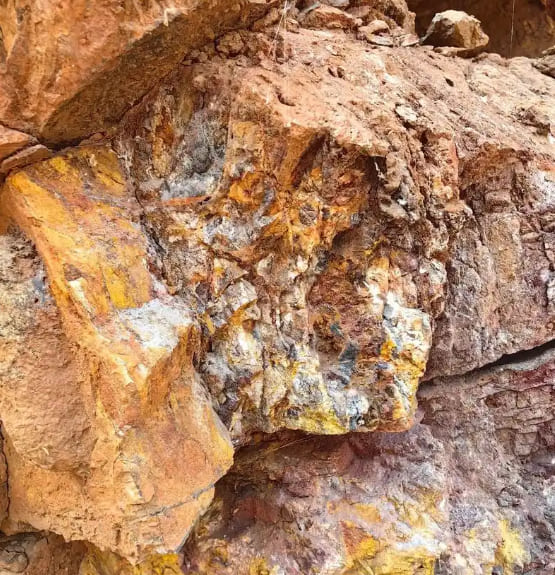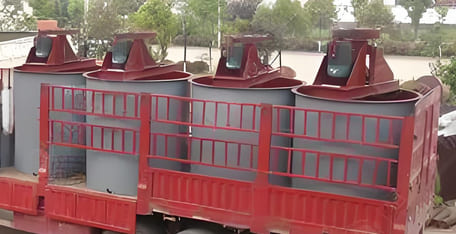Heap leaching has emerged as a cost-effective extraction method for certain types of gold ores, particularly those that meet specific geological and mineralogical criteria. Heap leaching for gold extraction generally yields relatively low gold recovery rates due to the coarse particle size of the ore and its weak interaction with cyanide leaching agents. Consequently, this method is typically suitable only for processing low-grade gold ores, particularly low-grade oxidized ores, most of which are surface-exposed oxidized deposits. The heap leaching technique involves stacking crushed ore into piles and applying a leaching solution (typically cyanide for gold) to percolate through the material, dissolving the target metal for subsequent recovery.
Extensive industrial practice has demonstrated that among oxidized ores suitable for heap leaching, gold occurs in various ore types, including gold-bearing quartz veins, gold-bearing breccias, structurally altered rocks, andesites, sandstone, porphyry, hydrothermally altered rocks, silicified melange, and secondary gold-bearing iron caps. Among these, gold with high oxidation levels, gold hosted within gangue or mineral fractures, and finely-grained, easily exposed gold are readily amenable to heap leaching.
Three Principal Ore Categories Suitable for Heap Leaching
Industrial experience categorizes heap-leachable gold ores into three main groups:
- Disseminated Oxidized Gold Ores: These deposits feature gold particles scattered throughout the host rock matrix in oxidized states.
- Sulfide Ores with Gold Liberation: Sulfide-bearing ores qualify when gold exists separately from sulfide minerals rather than in tight mineralogical associations.
- Lode or Placer Deposits with Microscopic Gold: Either vein deposits or alluvial accumulations containing very fine gold particles or gold with high surface area-to-volume ratios.
1. Disseminated Oxidized Gold Ores (Most Favorable)
Key Features:
- Highly weathered (oxidized) host rock (limonite, hematite)
- Gold occurs as liberated particles (>80% exposure)
- Low sulfide content (<0.5% S) → minimal cyanide consumption
- Naturally porous (~15-30% permeability)
Processing Considerations:
- Crushing: Typically requires P₈₀ ≤ 25 mm (or ROM if permeable)
- Agglomeration: Optional (if clay >30%, binder addition helps)
- Leach Cycle: 30–50 days (~70–85% recovery)
- Economic Cut-off Grade: 0.2–5 g/t Au
- Example Deposits: Carlin-type (USA), lateritic deposits (West Africa)
2. Sulfide Ores with Gold Liberation (Requires Pretreatment)
Key Features:
- Gold is not locked in sulfides (exposed due to weathering/fractures)
- Sulfide minerals (pyrite, arsenopyrite) <5% total (higher requires oxidation)
- Some acid generation possible (pH control crucial)
Processing Considerations:
- Crushing/Pre-treatment:
Ultrafine grinding (P₈₀ <75µm) if locked
Bio-oxidation/roasting (~500–700°C) for refractory ores - Agglomeration: Often needed (~3% cement)
- Leach Cycle: 60–120 days (~50–75% recovery)
- Economic Cut-off Grade: 0.8–2 g/t Au (higher due to costs)
Example Deposits: Partially oxidized volcanogenic massive sulfides (VMS)

3. Lode or Placer Deposits with Microscopic Gold (Fine-Grained Gold Ideal for Agglomeration)
Key Features:
- Gold grains are excellent (<50µm) and dispersed
- Common in quartz vein lodes or alluvial placers
- High surface area → rapid cyanide dissolution
Processing Considerations:
- Crushing: Achieve P₈₀ ≤ 10 mm (fine gold needs exposure)
- Agglomeration: Critical (~5% binder for fines retention)
- Heap Height: ≤6 m (avoid compaction losses)
- Leach Cycle: 15–30 days (~80% recovery possible)
- Economic Cut-off Grade: 0.5–0 g/t Au
Example Deposits: Epithermal vein systems (Mexico, Peru), paleoplacers (Brazil)
Comparative Summary Table
| Category | Optimal Grade (g/t Au) | Crushing (P₈₀) | Pretreatment Needed | Recovery (%) | Leach Cycle |
| Oxidized | 0.3–1.5 | ≤25 mm | No | 70–85% | 30–50 days |
| Sulfide-Liberated | 0.8–1.5 | ≤10 mm | Possibly | 50–75% | 60–120 days |
| Microscopic Gold | 0.5–1.0 | ≤10 mm | Agglomeration | 70–80% | 15–30 days |
Key Takeaways:
- Oxidized ores are easiest/cheapest to heap leach.
- Sulfide ores require liberation testing (MLA/SEM) before processing.
- Fine-grained gold ores benefit from agglomeration to prevent percolation issues.
Key Characteristics of Gold Ores Suitable for Heap Leaching
Heap leaching is an economically efficient extraction method for low-grade gold ores, but its success heavily depends on the physicochemical properties of the ore. Below are the six essential characteristics that make gold ore suitable for heap leaching, explained with technical details and industry practices.
1. Low Gold Grade
Typical Range: 1.0–3.0 g/t (some high-grade deposits may reach 5.0 g/t but require cost-benefit analysis).
Economic Rationale:
- Heap leaching has an operating cost (OPEX) of 5–15/ton, which is significantly lower than traditional methods like CIP/CIL (20–40/ton).
- At gold prices ≥$1,500/oz, the cut-off grade can drop to 0.3 g/t (e.g., some oxidized deposits in Nevada, USA).
2. Fine or Liberated Gold Particles
Ideal Liberation State:
- >80% of gold grains should be free or fully exposed to cyanide solution.
- Particle size <50 microns (if locked in sulfides, pre-oxidation may be needed).
Testing Methods:
- MLA (Mineral Liberation Analysis) or QEMSCAN to quantify gold exposure.
- Column leach tests to validate recovery rates.
3. High Permeability (Porous & Fractured Ore)
Permeability Requirements:
- Hydraulic conductivity >10⁻⁴ cm/s (prevents solution channeling or saturation).
- Porosity >15% (e.g., weathered oxides like iron caps or clay-altered zones).
Solutions for Compact Ores:
- Crush to P₈₀ ≤25 mm or apply agglomeration (3–5% cement/lime to bind fines).
4. Crush-Liberated Gold
Crushing Strategy:
- For hard rock (e.g., quartz vein gold), use three-stage crushing + HPGR (High-Pressure Grinding Rolls).
- Column leach tests to compare recovery rates at different crush sizes (e.g., P₈₀=10 mm vs. 25 mm).
5. Low Harmful Elements
| Detrimental Element | Maximum Threshold | Negative Impact | Mitigation Strategy |
| Sulfur (S) | <0.5% | Forms toxic HCN gas | Pre-oxidation (bio/chemical) |
| Copper (Cu) | <0.1% | Increases cyanide consumption | Use thiourea leaching |
| Arsenic (As) | <0.2% | Environmental hazard | Passivation (Fe³ precipitation) |
| Organic Carbon | <0.3% | Gold adsorption (“preg-robbing”) | Pre-treatment (roasting) |
6. No Gold-Absorbing Minerals
Common Preg-Robbing Materials: Activated carbon, graphite, swelling clays (e.g., montmorillonite).
Detection Methods: Diagnostic leach tests to differentiate “locked gold” from “gold loss due to adsorption.”
Key Takeaways
- Best Candidates: Highly oxidized, low-sulfur, porous ores with fine liberated gold.
- Potential Risks: High clay content (needs agglomeration), preg-robbing carbon (requires roasting).
- Economic Validation: Conduct column leach tests + breakeven grade analysis.
Generally speaking, gold ores suitable for heap leaching typically possess the following characteristics: low ore grade (mainly 1.0-3.0 g/t, with a few exceeding 3.0 g/t), fine-grained or flattened gold minerals, and a favorable distribution for cyanide leaching. The ore must also possess good permeability, often resulting in a loose, porous structure due to oxidative weathering, or be mechanically crushed to fully expose the gold. Ideally, the ore should be free of acidic components, interfering elements that are difficult to react with cyanide, and free of substances that adsorb or precipitate dissolved gold, to ensure a smooth leaching process and sufficient gold recovery.

Three Important Physical Properties of Heap Leaching Ore
When evaluating ore suitability for heap leaching, three important physical properties should be considered: fines content, saturated water capacity, and bulk density.
Fine content, typically referring to the proportion of ore material smaller than 74μm or 149μm, significantly affects permeability during heap leaching. The higher the fines content, the lower the permeability. When the fines content exceeds 5%, especially for particles smaller than 74μm, pelletizing for heap leaching is often necessary.
Saturated water capacity reflects the water content of the ore at saturation. This parameter also influences the permeability of the ore and is closely linked not only to the ore’s particle size but also to its mineral composition. For example, minerals such as kaolin, chlorite, and sericite are highly water-absorbent. When solution passes between ore particles, these minerals absorb large amounts of water and expand, potentially causing particle fragmentation, pulverization, and mudification, which in turn impairs the ore’s permeability.
In addition, bulk density, or bulk density, is also a factor to consider. During heap leaching, the combined influence of these physical properties will determine the leaching efficiency of the ore. This key parameter directly influences the relationship between heap volume and ore quality, and plays a crucial role in the heap leaching process.
